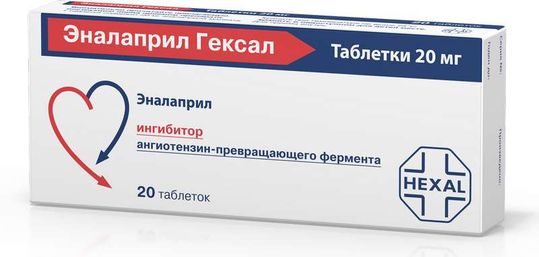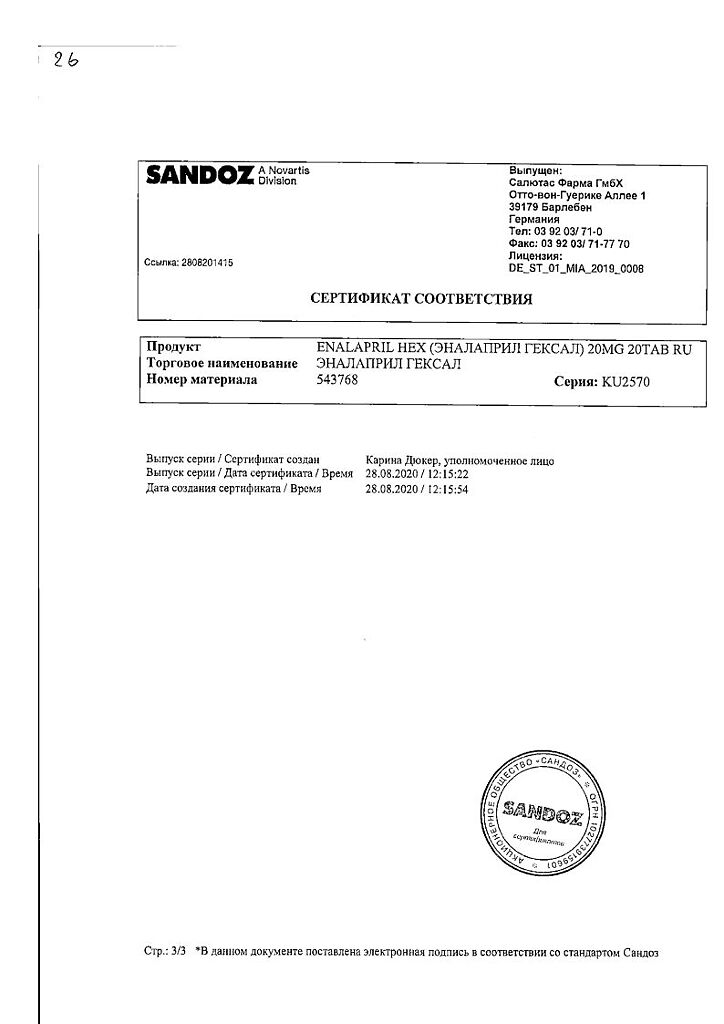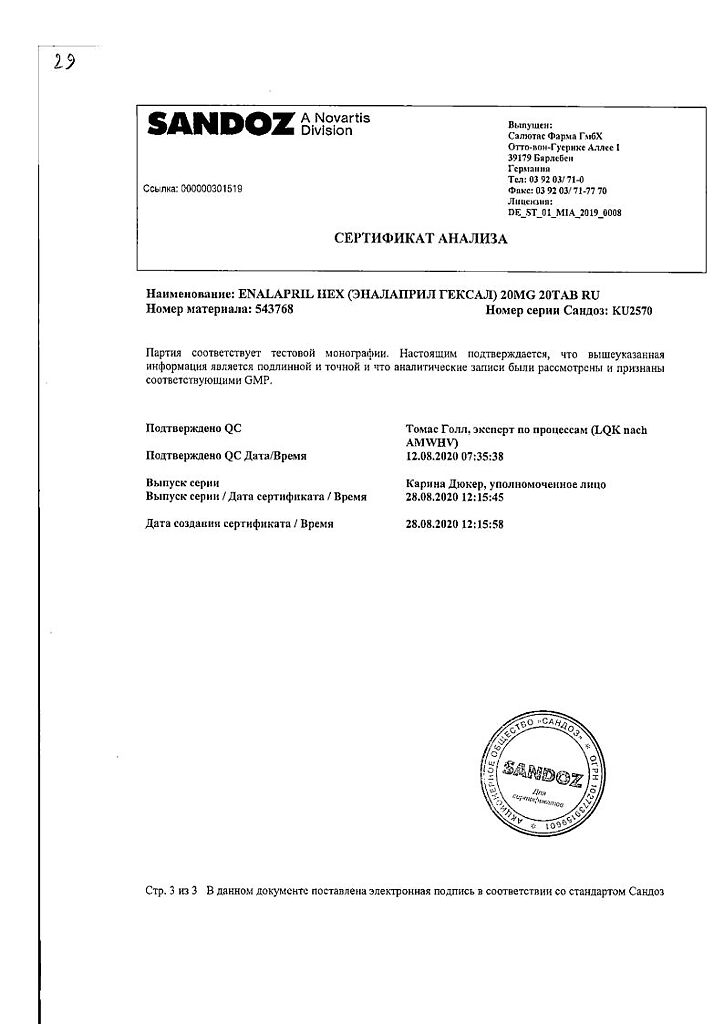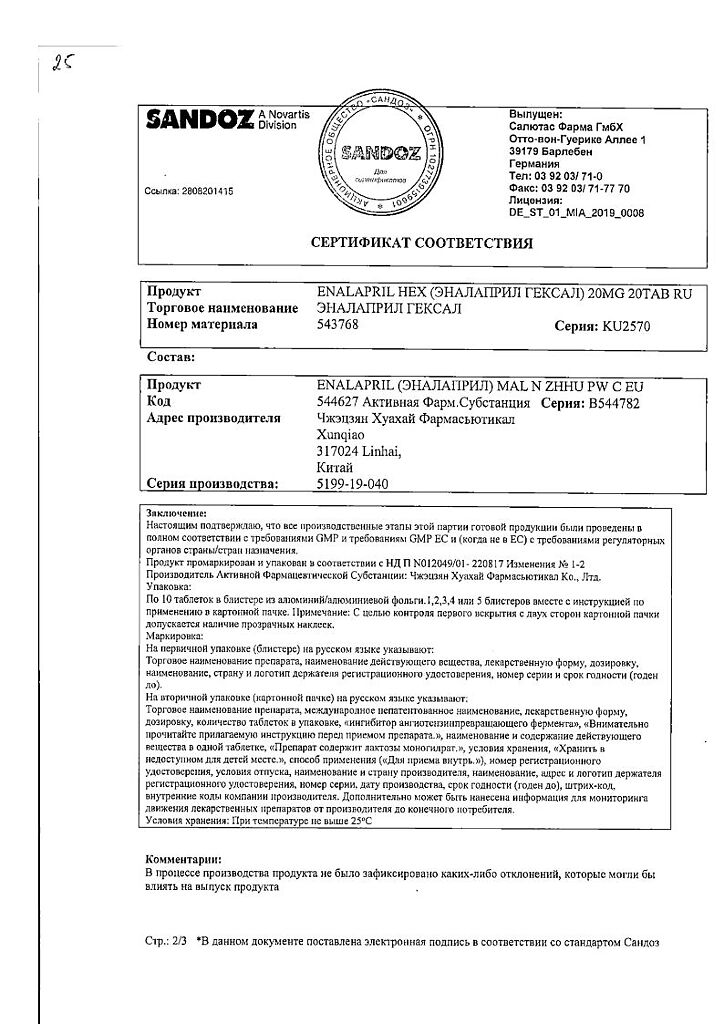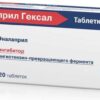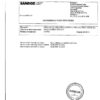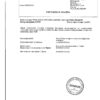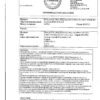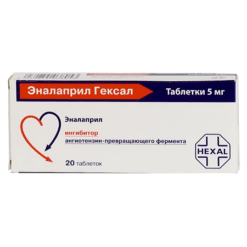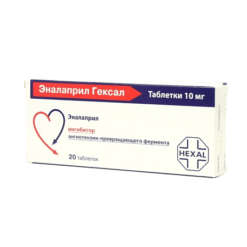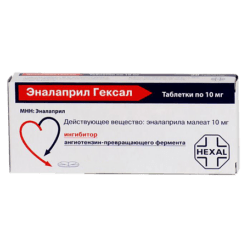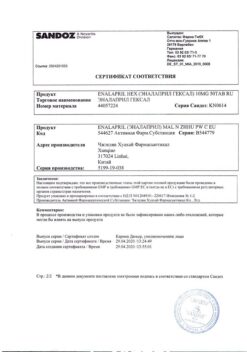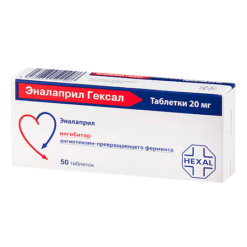No products in the cart.
Enalapril Hexal, tablets 20 mg 20 pcs
€3.32 €3.02
Description
Pharmacodynamics
Enalapril is an angiotensin-converting enzyme (ACE) inhibitor used to treat arterial hypertension, heart failure, and diabetic nephropathy. The clinical effect of enalapril is due to inhibition of ACE activity and, as a consequence, reduction of angiotensin II formation from angiotensin I in tissues and circulating blood. Reducing the concentration of angiotensin II, in turn, leads to vasodilation, decreased secretion of aldosterone, increased potassium and plasma renin concentration.
Hemodynamic consequences of these changes are reduction of total peripheral vascular resistance (TPR), systolic and diastolic blood pressure, increase of cardiac output, reduction of post- and preload on myocardium. Enalapril dilates arteries more than veins, and there is no reflex increase in heart rate (HR). It reduces bradykinin degradation and increases prostaglandin synthesis. Antihypertensive effect is more pronounced at high concentration of renin than at normal or reduced levels. Time of onset of antihypertensive effect when taken orally is 1 hour, which reaches a maximum after 4-6 hours and lasts up to 24 hours.
In some patients, therapy for several weeks is necessary to achieve optimal blood pressure (BP). In chronic heart failure noticeable clinical effect is observed with long-term treatment – 6 months or more. The duration of therapeutic effect is dose-dependent.
Vasodilating and some diuretic effect of enalapril are also provided by blockade of bradykinin destruction which in turn stimulates synthesis of vasodilatory and renal prostaglandins. Increased bradykinin both in blood plasma and locally in organs and tissues of the body blocks the pathological processes occurring in chronic heart failure in the myocardium, kidneys, vascular smooth muscle. At the same time there is an increase of coronary and renal blood flow, with long-term use (3-4 weeks of treatment) the hypertrophy of the left ventricle and myofibrils of the arterial walls of the resistive type decrease, the left ventricular dilatation slows and the blood supply of ischemic myocardium improves, metabolism improves and the frequency of arrhythmias after restoration of blood supply to the heart muscle decreases.
Moderate diuretic effect of the drug decreases intracolytic hypertension, slows down the development of glomerulosclerosis and reduces the risk of chronic renal failure.
The decrease of BP within therapeutic limits (not lower than 110/60 mm Hg) does not affect the cerebral blood flow: the blood supply to the brain is maintained at the appropriate level even against the background of reduced BP.
The abrupt withdrawal of the treatment does not lead to the withdrawal syndrome (sharp rise in BP).
Enalapril does not cause metabolic disorders, does not affect glucose metabolism, does not increase the concentration of uric acid, does not change the profile of blood lipoproteins. Enalapril may decrease hypokalemic effect of thiazide diuretics.
Pharmacokinetics
Vis absorption
.br> When taken orally, enalapril is rapidly absorbed, with maximum plasma concentration reached within 1 h.
Enalapril is well absorbed from the gastrointestinal tract (GIT), within 1 h (maximum 4-8 h) after oral administration the therapeutic effect is achieved. Food intake does not affect the absorption of the drug.
Distribution
In patients with normal renal function, the equilibrium plasma concentration of enalapril is reached on day 2-3 after the start of administration. It does not cumulate. Plasma protein binding is about 50%.
Elimation
Subjected to biotransformation in the liver to form the active metabolite – enalaprilat, the maximum concentration of which is determined 4 hours after intake. Excretion of enalapril is mainly through the kidneys – 60% (20% – as enalapril and 40% – as enalaprilat), through the intestine – 33% (6% – as enalapril and 27% – as enalaprilat). The elimination half-life (T1/2) is 11 hours.
In patients with a creatinine clearance (CK) less than 30 ml/min, the T1/2 of enalapril is increased. Decreased renal secretion of enalapril may increase hydrolysis to enalaprilate and increase extrarenal excretion of the drug.
The rate of hydrolysis of enalapril may be decreased in patients with hepatic impairment without decreased therapeutic effect.
It penetrates through the placental barrier. It is excreted with the breast milk. Practically does not penetrate the blood-brain barrier. Does not accumulate in any tissues and organs.
Indications
Indications
Enalapril is an ACE inhibitor. It is a prodrug from which the active metabolite enalaprilat is formed in the body. It is believed that the mechanism of antihypertensive action is connected with competitive inhibition of ACE activity, which leads to decrease of conversion rate of angiotensin I into angiotensin II (which has strong vasoconstrictor effect and stimulates secretion of aldosterone in adrenal cortex).
The decrease in angiotensin II concentration results in a secondary increase in plasma renin activity by eliminating the negative feedback of renin release and a direct decrease in aldosterone secretion. In addition, enalaprilat appears to influence the kinin-callicrein system by inhibiting the breakdown of bradykinin.
Because of its vasodilator effect, it decreases RPO (postload), congestion pressure in the pulmonary capillaries (preload) and resistance in the pulmonary vessels; it increases cardiac minute volume and exercise tolerance.
In patients with chronic heart failure, long-term use of enalapril increases exercise tolerance and reduces the severity of heart failure (assessed by NYHA criteria). Enalapril in patients with mild to moderate heart failure slows its progression and also slows the development of left ventricular dilatation. In left ventricular dysfunction, enalapril reduces the risk of major coronary outcomes (including the rate of myocardial infarction and the number of hospitalizations for unstable angina).
Pharmacokinetics
In oral administration about 60% is absorbed from the gastrointestinal tract. Simultaneous intake of food does not affect absorption. It is metabolized in the liver by hydrolysis to form enalaprilat, due to the pharmacological activity of which the hypotensive effect is realized. Binding of enalaprilat with plasma proteins is 50-60%.
The T1/2 of enalaprilat is 11 hours and increases with renal insufficiency. After oral administration, 60% of the dose is excreted by the kidneys (20% as enalapril, 40% as enalaprilat), 33% is excreted through the intestine (6% as enalapril, 27% as enalaprilat). After intravenous administration of enalaprilat, 100% is excreted unchanged by the kidneys.
Active ingredient
Active ingredient
Composition
Composition
1 tablet contains:
active ingredient:
enalapril malealate 5.0 mg/10.0 mg/20.0 mg;
excipients:
Sodium bicarbonate 2.6 mg/5.1 mg/10.2 mg;
Lactose monohydrate 129.8 mg/124.6 mg/117.8 mg;
Corn starch 22.4 mg/21.4 mg/13.9 mg;
Talt 6.0 mg/6.0 mg/6.0 mg;
Hyprolose 2.5 mg/-/-;
Magnesium stearate 1.7 mg/1.7 mg/1.7 mg;
Red iron oxide -/1.2 mg/0.1 mg;
Iron oxide yellow -/-/0.3 mg.
How to take, the dosage
How to take, the dosage
When administered orally, the initial dose is 2.5-5 mg once/ The average dose is 10-20 mg/ in 2 doses.
In intravenous administration, 1.25 mg every 6 hours. For excessive hypotension in patients with sodium deficiency and dehydration due to previous therapy with diuretics, patients receiving diuretics, as well as in cases of renal insufficiency, an initial dose of 625 mg is administered. If clinical response is inadequate, this dose may be repeated after 1 hour and treatment may be continued at a dose of 1.25 mg every 6 hours.
The maximum daily dose when given orally is 80 mg.
Interaction
Interaction
Concomitant use with immunosuppressants, cytostatics increases the risk of leukopenia.
Concomitant use of potassium-saving diuretics (including spironolactone, triamterene, amiloride), potassium preparations, salt substitutes and food supplements containing potassium may lead to hyperkalemia (especially in patients with renal impairment).Because ACE inhibitors decrease the content of aldosterone, which leads to potassium retention in the body against the background of potassium excretion restriction or its additional intake.
The simultaneous use of opioid analgesics and drugs for anesthesia increases the antihypertensive effect of enalapril.
The simultaneous use of “loop” diuretics, thiazide diuretics increases the antihypertensive effect. There is a risk of hypokalemia. Increased risk of impaired renal function.
In concomitant use with azathioprine anemia may occur due to inhibition of erythropoietin activity caused by ACE inhibitors and azathioprine.
“
Special Instructions
Special Instructions
Particular caution is used in patients with autoimmune diseases, diabetes mellitus, hepatic dysfunction, severe aortic stenosis, subaortic muscle stenosis of unclear genesis, hypertrophic cardiomyopathy, loss of fluid and salts. In case of previous saluretic treatment, particularly in patients with chronic heart failure, the risk of orthostatic hypotension increases, therefore the loss of fluids and salts should be compensated before starting enalapril treatment.
In long-term treatment with enalapril, peripheral blood counts should be monitored periodically. Sudden discontinuation of enalapril does not cause a sudden increase in BP.
In surgical interventions during enalapril treatment, arterial hypotension may develop, which should be corrected by administration of sufficient fluid.
Contraindications
Contraindications
Side effects
Side effects
CNS and peripheral nervous system disorders: dizziness, headache, fatigue, increased fatigue; very rarely with high doses – sleep disorders, nervousness, depression, balance disorders, paresthesias, tinnitus.
Cardiovascular system disorders: orthostatic hypotension, fainting, palpitations, heart pain; very rare with high doses – hot flashes.
The digestive system: nausea; rarely – dry mouth, abdominal pain, vomiting, diarrhea, constipation, liver disorders, increased liver transaminases activity, increased blood bilirubin concentration, hepatitis, pancreatitis; very rare in high doses – glossitis.
The hematopoietic system: rarely – neutropenia; in patients with autoimmune diseases – agranulocytosis.
Urinary system disorders: rare – renal dysfunction, proteinuria.
Respiratory system disorders: dry cough.
Reproductive system disorders: very rare when used in high doses – impotence.
Dermatological reactions: very rare in high doses – hair loss.
Allergic reactions: rarely – skin rash, Quincke’s edema.
Others: rarely – hyperkalemia, muscle cramps.
Overdose
Overdose
Symptoms: marked BP decrease, up to the development of collapse, myocardial infarction, acute cerebral circulation disorder or thromboembolic complications, convulsions, stupor.
Treatment: the patient is transferred to a horizontal position with a low headboard. In mild cases gastric lavage and oral administration of saline solution are indicated, in more severe cases – measures aimed at BP stabilization: intravenous infusion of saline solution, plasma substitutes, angiotensin II administration, hemodialysis if necessary (Enalaprilat excretion rate is 62 ml/min on average).
Pregnancy use
Pregnancy use
It is contraindicated in pregnancy.
Enalapril should be stopped immediately if pregnancy occurs.
Enalapril is excreted with breast milk. If its use is necessary during lactation, discontinuation of breastfeeding should be considered.
Similarities
Similarities
Additional information
| Shelf life | 3 years. |
|---|---|
| Conditions of storage | List B. Store in a dry place out of reach of children at 15 to 25°C. |
| Manufacturer | Salutas Pharma GmbH, Germany |
| Medication form | pills |
| Brand | Salutas Pharma GmbH |
Other forms…
Related products
Buy Enalapril Hexal, tablets 20 mg 20 pcs with delivery to USA, UK, Europe and over 120 other countries.

